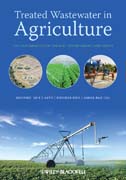
Treated wastewater in agriculture: use and impacts on the soil environments and crops
Levy, Guy
Fine, P.
Bart-Tal, A.
INDICE: Preface. Contributors list. Part I GENERAL ASPECTS. Chapter 1 Sources and composition of sewage effluent; treatment systems and methods (Renato Iannelli and David Giraldi). 1.1 Sources of usable wastewater. 1.1.1 Domestic and municipal wastewater. 1.1.2 Municipal, combined, and dedicated stormwater sewers. 1.1.3 Industrial wastewater. 1.2 Main characteristics of usable wastewater. 1.2.1 Potentially beneficial substances. 1.2.2 Harmful substances in sewage effluent. 1.2.3 Quantity considerations. 1.3 Wastewater treatments. 1.3.1 Classification of treatment stages. 1.3.2 Preliminary and primary treatments. 1.3.3 Secondary biological treatments. 1.3.4 Nutrient removal. 1.3.5 Disinfection. 1.3.6 Other tertiary chemico-physical treatments. 1.3.7 Membrane technologies and quaternary processes. 1.3.8 Natural treatments. 1.4 Framework for the selection of the optimal treatment train. References. Chapter 2 Health considerations in the recycling of water and use of treated wastewater in agricultureand other non-potable purposes (Hillel Shuval). 2.1 Introduction. 2.2 Rationale: why should society allow, regulate, and thus encourage exposure of the population to known health risks? 2.3 Persistence of pathogenic microorganisms inwater, soil, and on crops from wastewater-irrigation. 2.4 Disease transmission by wastewater-irrigation. 2.4.1 Illness associated with wastewater-irrigation of crops eaten raw. 2.4.2 Cattle grazing on wastewater-irrigated pastures. 2.4.3 Exposure of wastewater farmers. 2.4.4 Exposure of residents in the vicinity of wastewater farms. 2.4.5 Epidemiological evidence of beneficial effects from wastewater treatment in reducing exposure to pathogens. 2.4.6 Critical review of epidemiological evidence of health effects of wastewater and excreta use in agriculture. 2.4.7 Conclusions from the analysis of the epidemiological studies. 2.5 Control of crops and irrigation methods to reduce health risks. 2.5.1 Regulating the type of crops. 2.5.2 Controlling irrigation methods. 2.6 Development of health standards and guidelines for wastewater use. 2.6.1 The importance of health guidelines and standards for reuse. 2.6.2 The USEPA/USAID initiative for wastewater use health guidelines. 2.6.3 Impact of highly restrictive reuse guidelines and standards. 2.6.4 The World Bank/WHO initiative to re-evaluate wastewater use guidelines. 2.6.5 Evaluating the WHO's health guidelines for wastewater reuse in agriculture. 2.6.6 WHO guidelines for monitoring and validation. 2.7 Conclusions. References. Chapter 3 Irrigation with recycled water: guidelines and regulations (Nikolaos V. Paranychianakis, Miquel Salgot and Andreas N. Angelakis). Terminology definitions. 3.1 Introduction. 3.2 Historical development of water recycling and reuse regulations. 3.3 Water recycling in agriculture: quality issues. 3.3.1 Pathogens. 3.3.2 Biodegradable organic matter. 3.3.3
- ISBN: 978-1-4051-4862-7
- Editorial: Wiley-Blackwell
- Encuadernacion: Cartoné
- Páginas: 464
- Fecha Publicación: 05/11/2010
- Nº Volúmenes: 1
- Idioma: Inglés
